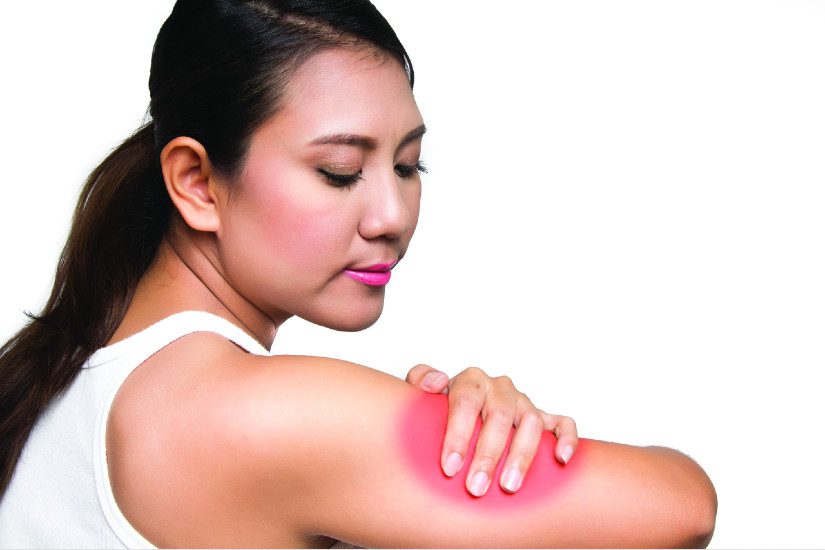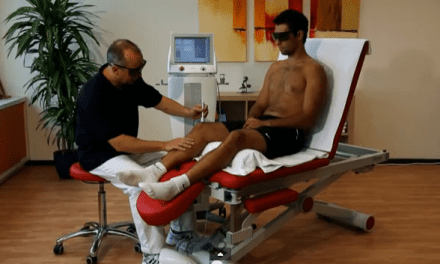PHOTO CAPTION: CRPS symptoms are typically limited to one region of the body, usually an upper or lower limb.
Treating clients with Complex Regional Pain Syndrome can require multiple therapeutic methods.
by John V. Rider, PhD, OTR/L, MSCS, CPAM
Although Complex Regional Pain Syndrome (CRPS) was first described in the 19th century, it is still commonly referred to as a “mysterious” and “debilitating” pain disorder due to its complex nature. CRPS is a broad term describing excessive and prolonged pain and inflammation occurring after upper or lower limb trauma. CRPS is difficult to diagnose, difficult to treat, and unlike other persistent pain conditions. Complex indicates the limited understanding and the variable disease course; regional is used because symptoms are typically limited to one region of the body, usually an upper or lower limb; and pain syndrome because the primary symptom is increased and excessive pain.
CRPS can be acute, lasting a short term, or chronic, lasting greater than 6 months. Some therapists might be more familiar with terms such as reflex sympathetic dystrophy (RSD), causalgia, or shoulder-hand syndrome, which were previously used for CRPS. CRPS affects up to 26.2 out of 100,000 people per year.1 While CRPS can affect all ages, it is more common in adults, specifically women, and incidence peaks around age 40.2
Although it is still unclear why some people develop CRPS and others with similar trauma do not, in more than 90% of cases, CRPS is triggered by nerve injury or trauma.3 This damage in peripheral sensory neurons leads to secondary effects on the central nervous system, resulting in pain and other symptoms that cannot be explained by the initial injury. Current evidence indicates many contributing factors to CRPS symptoms, further adding to its mystery and necessitating a client-centered and holistic approach to rehabilitation.
Type I vs Type II
CRPS is divided into two types based on whether a nerve injury can be identified. CRPS type I (approximately 90% of CRPS cases) indicates that there is uncertainty about the exact nerve injured, whereas type II indicates that the physician was able to identify a specific nerve that was injured. For therapists, the most important distinction between these two types is that nerve injuries in CRPS type I are usually more subtle and may go unnoticed until symptoms significantly impact daily life. However, symptoms are identical in both types.
Therapists should be aware that the most common actions or activities that lead to CRPS include, but are not limited to, fractures, sprains, strains, burns, cuts, limb immobilization, and surgery. Fractures are the most common cause, particularly in the wrist. Therapists should pay careful attention during rehabilitation after wrist fractures, such as the distal radius, and ensure casts or orthotics are not too tight or painful, as this may lead to CRPS. Currently, researchers believe poor circulation can further impede nerve and tissue healing, indicating that individuals with CRPS should elevate the affected arm or leg when resting or sleeping and engage in daily physical activity.3 Additionally, compression stockings or sleeves may limit swelling, and physical agent modalities can be used to improve circulation and decrease pain. Therapists can provide clients with skilled education and training on the nature of CRPS, positioning, precautions, adaptive methods for occupational engagement, physical activity recommendations, and safety with modalities and compression garments.
Addressing Symptoms
Symptoms of CRPS vary significantly with combinations of spontaneous or excessive pain. In general, pain is experienced from stimuli that do not normally provoke pain, posing significant concerns with daily activities as simple tasks (eg, getting dressed, showering) and everyday objects (eg, coffee cup or hairbrush) may cause pain. In addition to pain, CRPS is also characterized by sensory, autonomic, motor, or trophic (skin, fascia, muscle) symptoms that can no longer be explained by the initial injury. Living with CRPS can be debilitating, and people with CRPS generally report lower quality of life and have a higher suicide risk than other pain syndromes, indicating a need for therapists to perform comprehensive psychological screenings.4 Additionally, clients with CRPS have reported that they believe health professionals do not understand their experience, further contributing to the daily “battle” with this disease.4
CRPS symptoms include:
• Inflammation and edema
• Unprovoked or spontaneous pain or burning that can be constant or fluctuate with activity
• Excess or prolonged pain after use or contact of affected limb
• Increased sensitivity to temperature or touch
• Changes in skin texture, temperature, or color of affected limb
• Abnormal sweating and nail and hair growth
• Stiffness in affected joints
• Impaired muscle strength and movement
Treating CRPS
The most important treatment for CRPS is to keep the painful limb or body part moving. This helps to improve blood flow; lessen circulatory symptoms; and maintain flexibility, strength, and function. Maintaining movement and functional use also helps to prevent or reverse maladaptive neuroplastic changes commonly seen with disuse and persistent pain. Occupational therapists (OTs) can focus on maintaining engagement in preferred occupations by training clients on compensatory and adaptive techniques. Participating in meaningful activities can improve mental well-being, help promote normal movement and positioning, desensitize affected limbs, decrease muscle guarding, increase functional use of the limbs, and improve the processing of pain-triggering perceptual stimuli.
While occupational therapy and physical therapy (PT) interventions may overlap or be synergistic at times, combining the two has been found to be more beneficial in CRPS than physical therapy alone, resulting in increased independence with daily activities.6 OTs and PTs should collaborate when treating CRPS to ensure carryover between disciplines and comprehensive treatment.
A Varied Approach
CRPS often necessitates the use of multiple therapeutic approaches by both OT and PT. Non-pharmacological interventions such as mirror box therapy, graded motor imagery, tactile (sensory) discrimination training, desensitization training, virtual reality, therapeutic exercise, manual therapy, aquatic therapy, Kinesio taping, and forms of cognitive behavioral therapy have all demonstrated efficacy. Weight-bearing interventions, such as stress-loading protocols using scrubbing (constant and progressive forces through the affected limb) and carrying (carrying a weighted object for increasing periods), have also been used successfully with CRPS.
Each of these approaches has been studied across pain syndromes and many have evidence-based protocols for application among CRPS and persistent pain. Although these approaches are commonly covered in therapy school, advanced training is available through continuing education courses. Comprehensive treatment approaches may also include physical agent modalities.
TENS, PEMF, and Laser
Many physical agent modalities have also been shown to be beneficial in treating CRPS. A recent scoping review found that transcutaneous electrical nerve stimulation (TENS), pulsed electromagnetic field therapy (PEMF), and laser or light therapy, may contribute to reducing pain and improving function in clients with CRPS type I.7
TENS has shown to be an effective adjunct when coupled with other OT/PT interventions, such as graded exposure, pain neuroscience education, task-oriented training, therapeutic exercise, and manual therapy. TENS can be used in isolation or during functional activity and therapeutic exercise, and has been shown to improve range of motion and reduce pain in CRPS when used in combination with therapeutic exercise compared to sham TENS and therapeutic exercise.8 While TENS parameters vary significantly among the literature, in general, daily use for approximately 20 minutes with an amplitude that does not cause discomfort or muscle contraction is most effective.8
PEMF uses healthy electromagnetic frequencies to enhance overall health and wellness and has been shown to have positive benefits on pain and inflammation in CRPS. A recent study using PEMF for 20-minute sessions for 10 days demonstrated significant improvement in pain reduction and functional improvement at both the upper and lower limbs.9 PEMF therapy is thought to influence microvessels and blood flow, which might counteract the impaired microcirculation found in CRPS.7,10
Laser therapy has demonstrated analgesic and anti-inflammatory effects in CRPS, although the mechanism of action is still unclear.11 Laser therapy has been shown to be more effective than electrotherapy in clients who developed CRPS after a stroke.13 While further research is needed to fully understand the benefits and optimal parameters for using TENS, PEMF, and laser therapy, current data suggests that the inclusion of these modalities may contribute to reduced pain and improved function among clients with CRPS.
Additional Approaches
In addition, simple modalities such as heat and cold may help; however, the affected limb may be hypersensitive to temperature, and therapists should be cautious. Heat is often more beneficial than cold. Applying cold may relieve pain temporarily, but often worsens the CRPS symptoms afterward. Applying heat may offer relief on skin that feels cool and be helpful in preparation for therapy. Topical analgesics can be used to reduce hypersensitivity and should be discussed with the referring physician. Biofeedback can also be used to help clients learn to be more aware of their body and relax deeply, which can increase blood flow to the affected limb and decrease pain.
Summary
CRPS is a multifactorial disease characterized by multiple physical changes, including significant alterations in pain perception, leading to secondary physical and psychological dysfunction. It disrupts engagement and independence in daily activities, lowering quality of life and mental well-being. Assessment should be client-centered, holistic, and seek to understand the client’s pain experience. Despite the limited knowledge of CRPS pathophysiology and the difficult diagnostic process, evidence suggests that early rehabilitation approaches with occupational therapy and physical therapy can significantly improve pain and function.
There is no one specific treatment for CRPS. Many non-pharmacological treatments have demonstrated efficacy and multiple physical agent modalities, when coupled with these evidence-based approaches, can increase the benefits of rehabilitation among clients with CRPS. Our understanding of CRPS and effective treatment is constantly growing, and therapists working with this population should seek further training and keep up to date with new research to maintain competency and practice evidence-based therapy. RM
John V. Rider, PhD, OTR/L, MSCS, CPAM, is an assistant professor at Touro University Nevada in the School of Occupational Therapy. He also works as a community-based occupational therapist specializing in chronic neurological and orthopedic conditions for Good Life Therapy in Las Vegas. For more information, contact [email protected].
References
- de Mos M, de Bruijn AG, Huygen FJ, Dieleman JP, Stricker BH, Sturkenboom MC. The incidence of complex regional pain syndrome: A population-based study. Pain. May 2007;129(1-2):12-20. doi:10.1016/j.pain.2006.09.008
- Goh EL, Chidambaram S, Ma D. Complex regional pain syndrome: A recent update. Burns Trauma. 2017;5:2. doi:10.1186/s41038-016-0066-4
- Complex Regional Pain Syndrome Fact Sheet. National Institute of Neurological Disorders and Stroke. https://www.ninds.nih.gov/Disorders/Patient-Caregiver-Education/Fact-Sheets/Complex-Regional-Pain-Syndrome-Fact-Sheet. Published 2020. Accessed December 1, 2021.
- Johnston-Devin C, Oprescu F, Gray M, Wallis M. Patients describe their lived experiences of battling to live with complex regional pain syndrome. The Journal of Pain. 2021/09/01/ 2021;22(9):1111-1128. doi:https://doi.org/10.1016/j.jpain.2021.03.151
- IASP Task Force on Taxonomy, Part III: Pain terms, a current list with definitions and notes on usage. In: H. Merskey, N. Bogduk. Classification of Chronic Pain, Second Edition. Seattle: IASP press; 1994: 209-214.
- Rome L. The place of occupational therapy in rehabilitation strategies of complex regional pain syndrome: Comparative study of 60 cases. Hand Surg Rehabil. Oct 2016;35(5):355-362. doi:10.1016/j.hansur.2016.06.005
- Moretti A, Gimigliano F, Paoletta M, et al. Efficacy and effectiveness of physical agent modalities in complex regional pain syndrome type I: A scoping review. Applied sciences. 2021;11(4):1857. doi:10.3390/app11041857
- Bilgili A, Cakir T, Dogan SK, Ercalik T, Filiz MB, Toraman F. The effectiveness of transcutaneous electrical nerve stimulation in the management of patients with complex regional pain syndrome: A randomized, double-blinded, placebo-controlled prospective study. J Back Musculoskelet Rehabil. Nov 21 2016;29(4):661-671. doi:10.3233/BMR-160667
- Benedetti MG, Cavazzuti L, Mosca M, Fusaro I, Zati A. Bio-Electro-Magnetic-Energy-Regulation (BEMER) for the treatment of type I complex regional pain syndrome: A pilot study. Physiother Theory Pract. Apr 2020;36(4):498-506. doi:10.1080/09593985.2018.1491661
- Groeneweg G, Huygen FJ, Coderre TJ, Zijlstra FJ. Regulation of peripheral blood flow in complex regional pain syndrome: clinical implication for symptomatic relief and pain management. BMC Musculoskelet Disord. Sep 23 2009;10:116. doi:10.1186/1471-2474-10-116
- Ide Y. [Phototherapy for chronic pain treatment]. Masui. Nov 2009;58(11):1401-6.
- Huang Z, Ma J, Chen J, Shen B, Pei F, Kraus VB. The effectiveness of low-level laser therapy for nonspecific chronic low back pain: a systematic review and meta-analysis. Arthritis Res Ther. 2015;17(1):360-360.
- Karabegović A, Kapidzić-Duraković S, Ljuca F. Laser therapy of painful shoulder and shoulder-hand syndrome in treatment of patients after the stroke. Bosn J Basic Med Sci. 2009;9(1):59-65. doi:10.17305/bjbms.2009.2858





